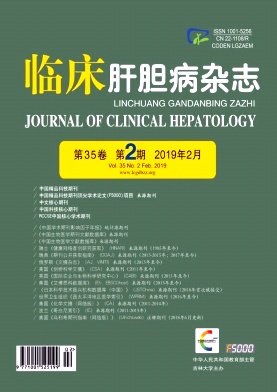|
[1]European Association for the Study of the Liver.EASL clinical practice guidelines:Management of chronic hepatitis B virus infection[J].J Hepatol, 2012, 57 (1) :167-185.
|
|
[2]Chinese Society of Hepatology and Chinese Society of Infectious Diseases, Chinese Medical Association.The guideline of prevention and treatment for hepatitis C:A 2015 update[J].JClin Hepatol, 2015, 31 (12) :1961-1979. (in Chinese) 中华医学会肝病学分会, 中华医学会感染病学分会.丙型肝炎防治指南 (2015年更新版) [J].临床肝胆病杂志, 2015, 31 (12) :1961-1979.
|
|
[3]LI Y, LIU L, LUO SL, et al.Association of direct-acting antiviral therapy for hepatitis C with the development and recurrence of liver cancer[J].J Clin Hepatol, 2018, 34 (2) :410-413. (in Chinese) 李砚, 刘蕾, 罗书兰, 等.丙型肝炎直接抗病毒治疗与肝癌发生及复发的关系[J].临床肝胆病杂志, 2018, 34 (2) :410-413.
|
|
[4]GAETA GB, PRECONE DF, FELACO FM, et al.Premature discontinuation of interferon plus ribavirin for adverse effects:A multicentre survey in'real world'patients with chronic hepatitis C[J].Aliment Pharmacol Ther, 2002, 16 (9) :1633-1639.
|
|
[5]FELLAY J, THOMPSON AJ, GE D, et al.ITPA gene variants protect against anaemia in patients treated for chronic hepatitis C[J].Nature, 2010, 464 (7287) :405-408.
|
|
[6]LIU Z, WANG S, QI W, et al.The relationship between ITPArs1127354 polymorphisms and efficacy of antiviral treatment in Northeast Chinese CHC patients[J].Medicine (Baltimore) , 2017, 96 (29) :e7554.
|
|
[7]OCHI H, MAEKAWA T, ABE H, et al.ITPA polymorphism affects ribavirin-induced anemia and outcomes of therapy-a genome-wide study of Japanese HCV virus patients[J].Gastroenterology, 2010, 139 (4) :1190-1197.
|
|
[8]WANG ML, PAN Y, JIANG J, et al.Association between ITPAgene variation and anemia during treatment with interferon combined with ribavirin[J].Chin J Gerontol, 2013, 33 (12) :2759-2761. (in Chinese) 王茉莉, 潘煜, 姜晶, 等.ITPA基因变异与干扰素联合利巴韦林治疗过程中发生贫血的相关性[J].中国老年学杂志, 2013, 33 (12) :2759-2761.
|
|
[9]HOLMES JA, ROBERTS SK, ALI RJ, et al.ITPA genotype protects against anemia during peginterferon and ribavirin therapy but does not influence virological response[J].Hepatology, 2014, 59 (6) :2152-2160.
|
|
[10]THOMPSON AJ, FELLAY J, PATEL K, et al.Variants in the IT-PA gene protect against ribavirin-induced hemolytic anemia and decrease the need for ribavirin dose reduction[J].Gastroenterology, 2010, 139 (4) :1181-1189.
|
|
[11]DENG HH, XU M, LI XQ, et al.Correlation of inosine triphosphate pyrophosphatase single nucleotide polymorphism and ribavirin-related anemia in patients with chronic hepatitis C in Guangzhou[J/CD].Chin J Exp Clin Infect Dis:Electronic E-dition, 2017, 11 (2) :168-171. (in Chinese) 邓浩辉, 许敏, 李晓强, 等.广州地区丙型肝炎患者肌苷三磷酸酶基因多态性与利巴韦林所致贫血的相关性[J/CD].中华实验和临床感染病杂志:电子版, 2017, 11 (2) :168-171.
|
|
[12]VAN VLIERBERGH H, deLANGHE JR, de VOS M, et al.Factors influencing ribavirin-induced hemolysis[J].J Hepatol, 2001, 34 (6) :911-916.
|
|
[13]NOMURA H, TANIMOTO H, KAJIWARA E, et al.Factors contributing to ribavirin-induced anemia[J].J Gastroenterol Hepatol, 2004, 19 (11) :1312-1317.
|
|
[14]TAKAKI S, TSUBOTA A, HOSAKA T, et al.Factors contributing to ribavirin dose reduction due to anemia during interferon alfa2b and ribavirin combination therapy for chronic hepatitis C[J].J Gastroenterol, 2004, 39 (7) :668-673.
|









 本站查看
本站查看




 DownLoad:
DownLoad: